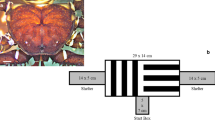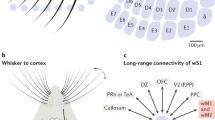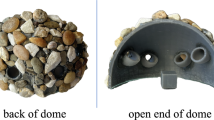Abstract
The ability of animals to learn and remember underpins many behavioural actions and can be crucial for survival in certain contexts, for example in finding and recognising a habitual refuge. The sensory cues that an animal learns in such situations are to an extent determined by its own sensory specialisations. Whip spiders (Arachnida, Amblypygi) are nocturnal and possess uniquely specialised sensory systems that include elongated ‘antenniform’ forelegs specialised for use as chemo- and mechanosensory feelers. We tested the tactile learning abilities of the whip spider Phrynus marginemaculatus in a maze learning task with two tactile cues of different texture—one associated with an accessible refuge, and the other with an inaccessible refuge. Over ten training trials, whip spiders got faster and more accurate at finding the accessible refuge. During a subsequent test trial where both refuges were inaccessible, whip spiders searched for significantly longer at the tactile cue previously associated with the accessible refuge. Using high-speed cinematography, we describe three distinct antenniform leg movements used by whip spiders during tactile examination. We discuss the potential importance of tactile learning in whip spider behaviour and a possible role for their unique giant sensory neurons in accessing tactile information.




Similar content being viewed by others
Abbreviations
- CS:
-
Conditioned stimulus
- fps:
-
Frames per second
- GN:
-
Giant neuron
References
Arabzadeh E, Petersen RS, Diamond ME (2003) Encoding of whisker vibration by rat barrel cortex neurons: implications for texture discrimination. J Neurosci 23:9146–9154
Beck L, Görke K (1974) Tagesperiodik, revierverhalten und beutefang der geisselspinne Admetus pumilio C.L. Koch im freiland. Z Tierpsychol 35:173–186
Collett TS, Collett M (2002) Memory use in insect visual navigation. Nat Rev Neurosci 3:542–552
de Armas LF, Víquez C (2001) Nueva especie de Phrynus (Amblypygi: Phrynidae) de Costa Rica. Rev Iber Aracnol 4:11–15
Dittman A, Quinn T (1996) Homing in pacific salmon: mechanisms and ecological basis. J Exp Biol 199:83–91
Dyer FC (1998) Cognitive ecology of navigation. In: Dukas R (ed) Cognitive ecology: the evolutionary ecology of information processing and decision making. University of Chicago Press, Chicago
Erber J, Kierzek S, Sander E, Grandy K (1998) Tactile learning in the honeybee. J Comp Physiol A 183:737–744
Foelix RF, Hebets EA (2001) Sensory biology of whip spiders (Arachnida, Amblypygi). Andrias 15:129–140
Goyret J, Raguso RA (2006) The role of mechanosensory input in flower handling efficiency and learning by Manduca sexta. J Exp Biol 209:1585–1593
Hebets EA (2002) Relating the unique sensory system of amblypygids to the ecology and behavior of Phrynus parvulus from Costa Rica (Arachnida, Amblypygi). Can J Zool 80:286–295
Hebets EA, Chapman RF (2000) Electrophysiological studies of olfaction in the whip spider Phrynus parvulus (Arachnida, Amblypygi). J Insect Physiol 46:1441–1448
Igelmund P (1987) Morphology, sense organs and regeneration of the forelegs (whips) of the whip spider Heterophrynus elaphus (Arachnida, Amblypygi). J Morphol 193:75–89
Igelmund P, Wendler G (1991a) The giant fiber system in the forelegs (whips) of the whip spider Heterophrynus elaphus Pocock (Arachnida: Amblypygi). J Comp Physiol A 168:63–73
Igelmund P, Wendler G (1991b) Morphology and physiology of peripheral giant interneurons in the forelegs (whips) of the whip spider Heterophrynus elaphus Pocock (Arachnida: Amblygi). J Comp Physiol A 168:75–83
Kevan PG, Lane MA (1985) Flower petal microtexture is a tactile cue for bees. Proc Natl Acad Sci USA 82:4750–4752
Nørgaard T, Nilsson D-E, Henschel JR, Garm A, Wehner R (2008) Vision in the nocturnal wandering spider Leucorchestris arenicola (Araneae: Sparassidae). J Exp Biol 211:816–823
Seidl T, Wehner R (2006) Visual and tactile learning of ground structures in desert ants. J Exp Biol 209:3336–3344
Shettleworth SJ (1998) Cognition, evolution, and behavior. Oxford University Press, New York
Spence AJ, Hebets EA (2007) Anatomy and physiology of giant neurons in the antenniform leg of the amblypygid Phrynus marginemaculatus. J Arachnol 34:566–577
Warrant EJ, Kelbur A, Gislén A, Greiner B, Ribi W, Wcislo WT (2004) Nocturnal vision and landmark orientation in a tropical halictid bee. Curr Biol 14:1309–1318
Weygoldt P (1977) Coexistence of two species of whip spiders (genus Heterophrynus) in the neotropical rain forest (Arachnida, Amblypygi). Oecologia 27:363–370
Weygoldt P (2000) Whip spiders (Chelicerata: Amblypygi). Their biology, morphology and systematics. Apollo Books, Stenstrup
Zar JH (1999) Biostatistical analysis, 4th edn edn. Prentice Hall, Upper Saddle River
Acknowledgments
We thank the U.S. Fish and Wildlife Service and National Key Deer Refuge for permitting whip spider collection; D.P. Franklin for help conducting preliminary observations; K.A. Swoboda for animal care; D.J. Wilgers for calibrating illumination in our experimental arena; and R.M. Adams, K.D. Fowler-Finn, A.S. Rundus, S.K. Schwartz, C.A. Wei, D.J. Wilgers, and R.H. Willemart for comments on this manuscript. This work was funded by a Searle Foundation Scholars grant to E.A. Hebets. These experiments comply with the ‘Principles of animal care’, publication No. 86-23, revised 1985 of the National Institute of Health, and also with the current laws of the United States of America.
Author information
Authors and Affiliations
Corresponding author
Rights and permissions
About this article
Cite this article
Santer, R.D., Hebets, E.A. Tactile learning by a whip spider, Phrynus marginemaculatus C.L. Koch (Arachnida, Amblypygi). J Comp Physiol A 195, 393–399 (2009). https://doi.org/10.1007/s00359-009-0417-8
Received:
Revised:
Accepted:
Published:
Issue Date:
DOI: https://doi.org/10.1007/s00359-009-0417-8




